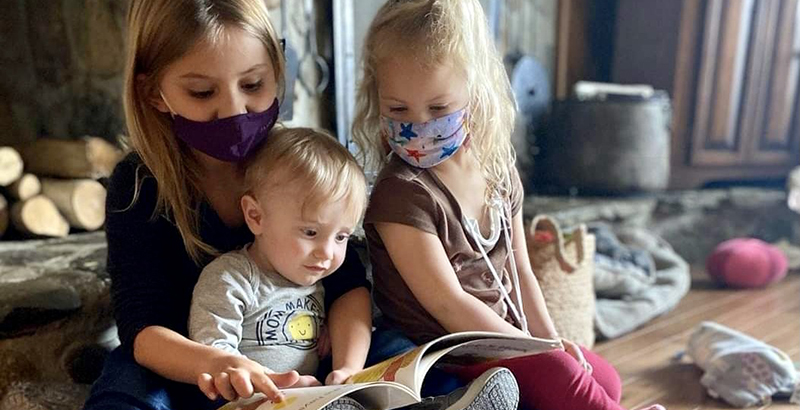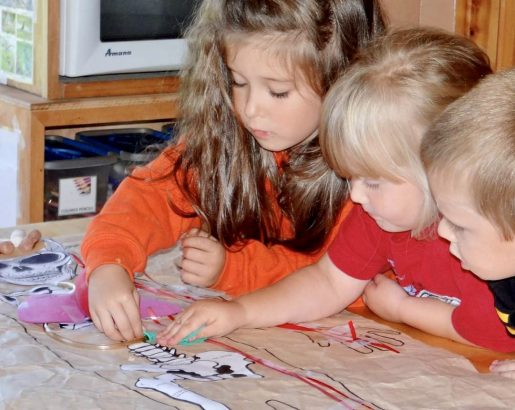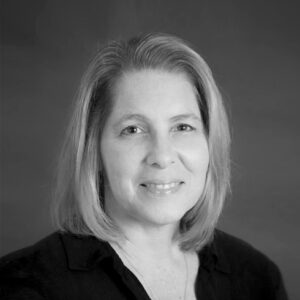As Biden Pushes Nation Toward Universal Pre-K, Home-Based Child Care Could Help Fill Gaps in the System. But a New Report Urges Caution

Get stories like this delivered straight to your inbox. Sign up for The 74 Newsletter
When a little girl in Chris Nelson’s family child care center painted a picture of a purple cow, a boy in the program was quick to correct her: Cows, he said, could only be black and white. So the North Troy, Vermont, provider began organizing cow-related field trips so the preschoolers could reach their own conclusions.
Over the next year, they visited dairy farms, brushed Highland cattle’s long hair, and branched off to learn about elk, deer and llamas. They read stories about cows, counted cows and compared different breeds. That’s the kind of child-led learning experience that Nelson plans to continue this fall when she participates for the first time in Vermont’s Universal Prekindergarten program.
“We base our curriculum on children’s interests,” said Nelson, who has 26 years of experience in the field and even has former students who enroll their own children in her program. “We know the kids’ learning style. We have a history with them.”

Allowing providers such as Nelson to participate in a publicly funded pre-K system could speed up the timeline for providing universal access to 3- and 4-year-olds — along with tuition-free community college, the other half of President Joe Biden’s plan to provide four more years of free public education. But a new report from the National Institute for Early Education Research and Home Grown, an organization working to improve home-based child care, suggests it’s not that simple. Including family child care in pre-K initiatives could satisfy parents who prefer their home-like environment and increase the supply of preschool programs in communities with limited supply, the authors say. However, they caution policymakers against expecting in-home providers to immediately meet the same standards and regulations as pre-K centers.
As Congress begins writing a $3.5 trillion plan that is expected to include $200 billion for early-childhood education, the report recommends lawmakers take a gradual approach that considers the perspectives of providers and parents.
“It’s really tricky for home-based providers. They lose out when they don’t get included [in public pre-K programs],” said Natalie Renew, Home Grown’s director. But pre-K systems that are primarily oriented toward schools and centers also disadvantage the providers and the families they serve, she added.
The primary downside, she said, is that if more home-based providers seek state funds to serve just preschoolers that could mean less space for infants and toddlers, space that is already in short supply. Working parents are more likely to choose family child care over centers for babies and toddlers, surveys show.
According to a summary of Biden’s American Families Plan, families would be able to “choose the settings that work best for them.”
‘People coming into your home’
Parents often prefer family child care because it offers a more personalized environment, allows them to keep siblings in the same program and can offer flexible hours that centers can’t accommodate. Including home-based providers in state pre-K also could further diversify the workforce, allowing parents to find caregivers that reflect their culture and speak their language.
Family child care providers have to meet requirements to be licensed, but many state pre-K regulations regarding facility space, hours of instruction and education requirements for teachers don’t easily translate to someone who cares for children in their living room. State funding could be a predictable source of income for providers, but it also means “more people coming into your home” to monitor compliance, Renew said.
New Jersey, for one, requires pre-K classrooms to be 950 square feet. “Would homes need dedicated spaces for the pre-K program with minimum square footage per child equivalent to the classroom requirement?” the authors ask.
States often require lead pre-K teachers to have a two- or four-year degree and special training in child development. Currently almost 50 percent of home-based providers have no college education, according to the report.
Educational requirements could increase the quality of family child care, but Renew said there’s a mismatch between most college-level early-childhood programs and the realities of family child care — especially around implementing a pre-K curriculum for 3- and 4-year-olds while still attending to the needs of babies and toddlers.
“It doesn’t work if we turn every family child care provider into a teeny tiny center,” she said.
Lanette Dumas, executive director of the National Association for Family Child Care, said she’s encouraged by the direction the administration is taking, but wants funding for an “on-ramp” to help providers earn degrees and make other modifications to their programs.
Finally, Renew added, there’s a false assumption that home-based child care is cheaper. The report argues that including such providers on a large scale could end up costing more.
In the Seattle Preschool Program, for example, a coach or consultant visiting a center would provide training for two to four teachers at once and “indirectly impact up to 40 kids,” said Monica Liang-Aguirre, who leads the program at the Seattle Department of Education and Early Learning. With family child care, that same coach might be working with one provider who serves maybe two or three children. The coach is still receiving the same pay and likely has added travel expenses to reach at-home providers.
Renew said there’s not yet enough research on whether children benefit from home-based pre-K programs in the same way they do in centers.
San Francisco has the most experience, with at-home providers representing 18 percent of the city’s pre-K sites. In Seattle’s program, funded by a local tax levy, 25 at-home providers — about 2 percent of the overall number — are expected to participate this fall.
Liang-Aguirre said the department waived the bachelor’s degree requirement because it wasn’t realistic for home-based providers. The majority are immigrants and speak languages other than English.
They serve families that are often reluctant to use out-of-home care and are “trying to figure out if it’s a good idea to let their children go to preschool,” Liang-Aguirre said. “We see it as a really important model and an important way to make preschool accessible for all families.”
Get stories like these delivered straight to your inbox. Sign up for The 74 Newsletter

;)
